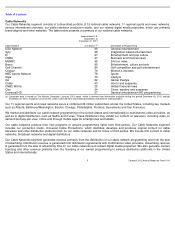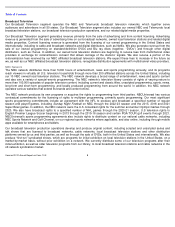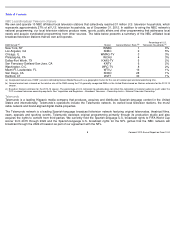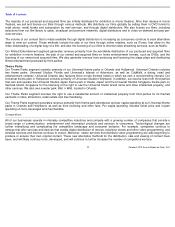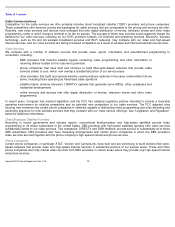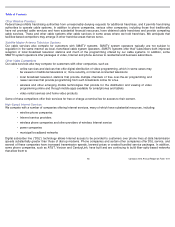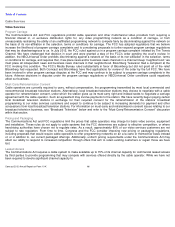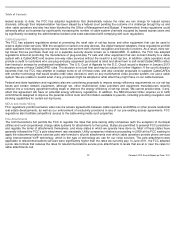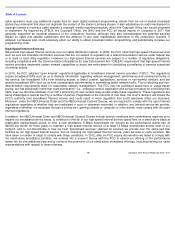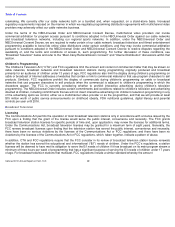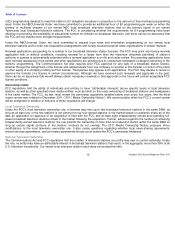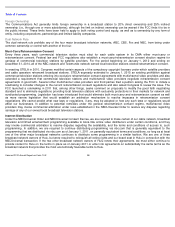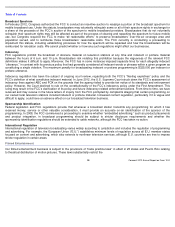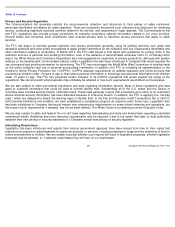Comcast 2012 Annual Report Download - page 20
Download and view the complete annual report
Please find page 20 of the 2012 Comcast annual report below. You can navigate through the pages in the report by either clicking on the pages listed below, or by using the keyword search tool below to find specific information within the annual report.
Table of Contents
leased access to date, the FCC has adopted regulations that dramatically reduce the rates we can charge for leased access
channels, although their implementation has been stayed by a federal court pending the outcome of a challenge brought by us and
other cable operators and also has been blocked by the Office of Management and Budget. If implemented, these regulations could
adversely affect our business by significantly increasing the number of cable system channels occupied by leased access users and
by significantly increasing the administrative burdens and costs associated with complying with such regulations.
Cable Equipment
The FCC has adopted regulations aimed at promoting the retail sale of set-
top boxes and other equipment that can be used to
receive digital video services. With the exception of certain one-
way devices, like digital transport adapters, these regulations prohibit
cable operators from deploying new set-top boxes that perform both channel navigation and security functions. As a result, most set-
top boxes that we purchase must rely on a separate security device known as a CableCARD. In addition, the FCC has adopted
regulations aimed at promoting the manufacture of plug-and-
play TV sets and other equipment that can connect directly to a cable
system with a CableCARD and receive one-way video services without the need for a set-
top box. In addition, cable operators must
provide a credit to customers who use plug-and-play equipment purchased at retail and allow them to self-
install CableCARDs rather
than having to arrange for professional installation. The U.S. Court of Appeals for the D.C. Circuit issued a decision in January 2013
vacating some of these CableCARD rules. The decision is not yet final and may be subject to further litigation. If the court’
s decision
becomes final, the FCC may attempt to readopt some or all of these rules, and also consider proposals to supplant CableCARDs
with another technology that would enable retail video devices to work on any multichannel video provider system, not just a cable
system. We are unable to predict what, if any, proposals might be adopted or what effect they might have on our cable business.
Federal and state legislators and regulators also are considering proposals to impose energy efficiency requirements on our set-
top
boxes and certain network equipment, although we, other multichannel video providers and equipment manufacturers recently
entered into a voluntary agreement taking steps to improve the energy efficiency of set-
top boxes. We cannot predict what, if any,
effect this agreement will have on potential energy efficiency regulations. In addition, the NBCUniversal Order requires us to fulfill
commitments designed to improve the parental control tools and information available to parents, including providing navigation and
blocking capabilities for certain set-top boxes.
MDUs and Inside Wiring
FCC regulations prohibit exclusive video service access agreements between cable operators and MDUs or other private residential
real estate developments, as well as our enforcement of exclusivity provisions in any of our pre-
existing access agreements. FCC
regulations also facilitate competitors’ access to the cable wiring inside such properties.
Pole Attachments
The Communications Act permits the FCC to regulate the rates that pole-
owning utility companies (with the exception of municipal
utilities and rural cooperatives) charge cable systems for attachments to their poles. States are permitted to preempt FCC jurisdiction
and regulate the terms of attachments themselves, and many states in which we operate have done so. Most of these states have
generally followed the FCC’
s pole attachment rate standards. Utility companies initiated a proceeding in 2009 at the FCC seeking to
apply the telecommunications services pole rate formula to all pole attachments over which cable operators provide phone services
using interconnected VoIP technology, which is the type of technology we use for our voice services. The pole attachment rates
applicable to telecommunications services were significantly higher than the rates we currently pay. In June 2011, the FCC adopted
a pole rate formula that reduces the rates for telecommunications service pole attachments to levels that are at or near the rates for
cable attachments, but
17
Comcast 2012 Annual Report on Form 10-
K


